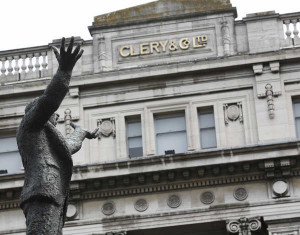Don’t dwell on the negatives

In encouraging news for retailers, the latest Consumer Confidence Index and the CSO’s retail sales figures have both risen. But will Ireland’s emerging economic positivity be enough to cushion the blow of a potential Grexit, asks Dan White
10 July 2015
The best consumer confidence figures for nine years and the continuing rise in the value of retail sales show that Irish shoppers have yet to be deterred by the uncertainty generated by the ongoing Greek crisis.
At the time of going to press Greece was still, just about, in the euro. However, unlike the nervousness which accompanied previous Greek crises in 2010 and 2012, the reaction this time around has been far more relaxed. No-one is speaking of “contagion” or questioning the future of the single currency. Instead we have been assured that the “firewalls” that have been put in place since the last crisis will prove sufficient to hold the euro together.
Ireland’s improvement
All of which is no bad thing for us here in Ireland. With the ESRI forecasting a 4% increase in GNP (by far the best measure of the performance of the domestic economy) for 2015, the last thing we need is a Greek-induced case of the jitters spoiling it all for us.
The evidence, at least so far, suggests that this isn’t happening. The ESRI/KBC Bank climbed to its highest level for nine years in June. The overall index figure now stands at 102.8, its highest since February 2006 when it stood at 102.9.
So what does this all mean and why does it matter? In broad terms the Consumer Confidence Index is the percentage of consumers who are optimistic about their present and future financial prospects less those who are pessimistic plus 100. This means that a situation where the percentage of consumers who were optimistic about their finances was exactly matched the percentage of consumers who were negative would produce an index figure of 100.
Majority are optimistic
So the June index figure of 102.8 shows that a majority of consumers are in an optimistic mood once again. While the majority of consumers who are optimistic is still a relatively small one, it represents a huge improvement on the dog days of 2008 and 2009 when the index figure fell to the low 40s, i.e. the proportion of consumers who were pessimistic about their prospects exceeded those who were optimistic by a margin of almost four to one.
The Consumer Confidence Index wasn’t the only piece of good news for retailers. The CSO’s latest index of retail sales figures show that the value of retail sales, excluding the volatile motor trade, rose by 2.5% in May compared to the same month in 2014. The value of non-motor retail sales has now risen for 18 consecutive months.
The value of sales rose in all of the major retail categories except food sales (down 1.7%) and fuel (down 4.8%). The value of book, stationery and newspaper sales rose by 9.7%, electrical goods sales rose by 5% in value terms while the value of clothing, footwear and textile sales rose by 4.3%.
Narrow gap between success and failure

As the abrupt closure of Clerys demonstrated, conditions remain tough for most of Ireland’s retailers
However, as the abrupt closure of venerable Dublin department store Clerys last month demonstrated, conditions remain tough for most of Ireland’s retailers with the gap between success and failure still a very narrow one.
A detailed examination of the retail sales index figures provides further evidence of just how difficult the environment remains for the country’s retailers. They show that while the value of non-motor retail sales rose by 2.5% in May the volume of retail sales rose by 5.5%. In other words retailers are still being forced to cut prices by an average of about 3% annually in order to keep shoppers coming through their doors.
This deflation is particularly severe in some retail sectors. While the value of clothing and footwear sales rose by 4.3% in the year to May, the volume rose by 7.9% implying a fall in prices of approximately 3.5%. The value of electrical goods sales rose by 5% but the volume of such sales rose by 10.3%, which points to a fall in prices in excess of 5%. However, the most severe fall in prices occurred in the “other retail sales” category where there was a 10.7% increase in the value of sales but a 17.3% increase by volume, i.e. a fall in prices of approximately 6%.
Grocery sector’s issues
Falling prices were less severe for food retailers with the value of food sales falling by 1.7% in the year to May but the volume of such sales was up by a minuscule 0.1% over the same period, according to the CSO.
Of course the grocery sector has its own issues. The rise and rise of the German discounters Aldi and Lidl continues unabated with the latest figures from Kantar Worldpanel showing that their combined market share has now risen to 17%. This leaves the other food retailers scrapping for a shrinking share of a market that is barely growing in volume terms and contracting in value terms.
Tesco, which has recently regained the top slot in the Irish grocery market, has not been immune from these trends with sales at its Irish subsidiary falling by almost 5% to €2.56bn in the year to February. Republic of Ireland sales at Musgrave, owner of the SuperValu and Centra retail franchises, were broadly flat at €3.13bn in 2013 – Musgrave has yet to publish its 2014 figures while there is no financial data available for the other major player, Dunnes Stores.
Glass half full
Perhaps one shouldn’t dwell too much on the negatives. For the first time in almost a decade the glass is half full rather than half empty for most of the country’s retailers. Employment is still growing strongly – although the increase in the number of jobs is only slowly feeding through into earnings with average earnings up by just 0.5% over the past year.
This year’s strong growth in the domestic economy looks set to continue into next year with the ESRI forecasting GNP growth of 3.5% in 2016 with the unemployment rate falling to 9.7% this year and 8.4% next year.
Will these strong tailwinds be sufficient to offset the negative impact of a possible Greek exit from the euro and perhaps higher interest rates in the near future also? We can only hope that they are.



 Print
Print




Fans 0
Followers